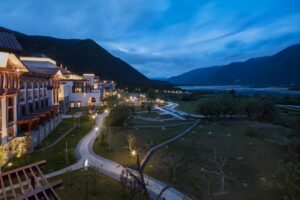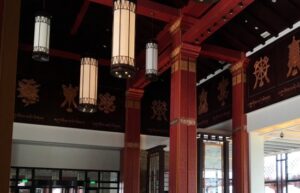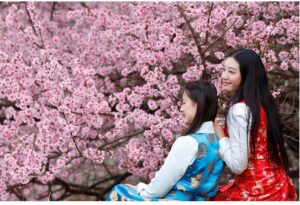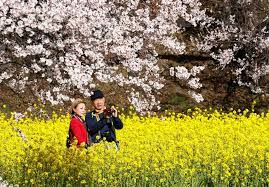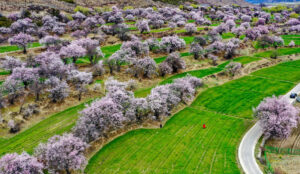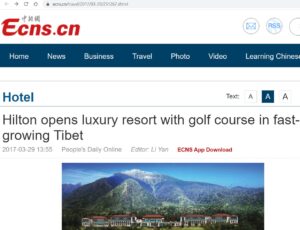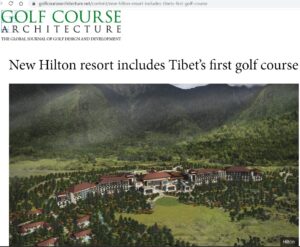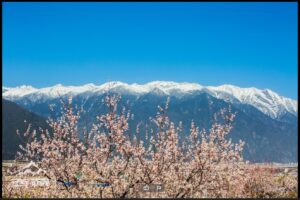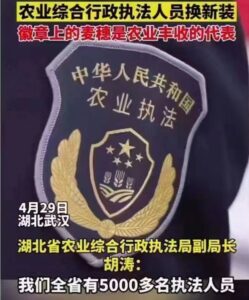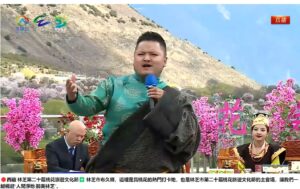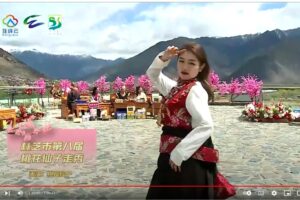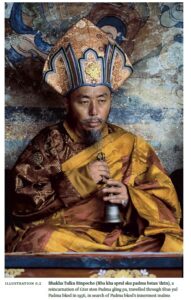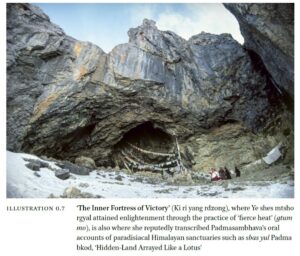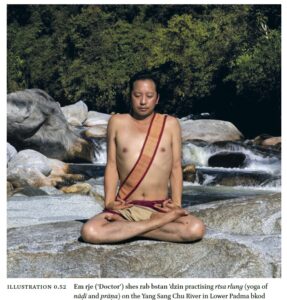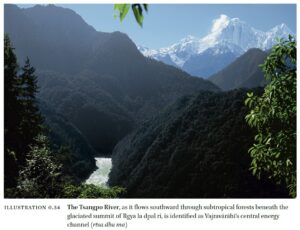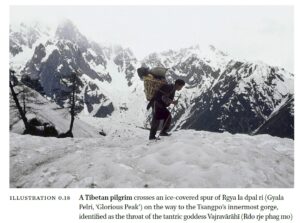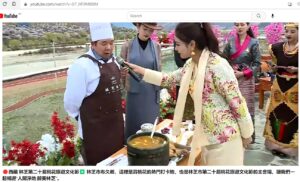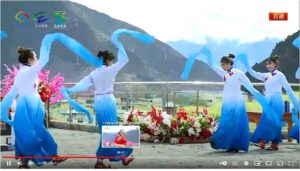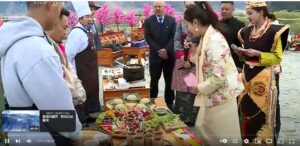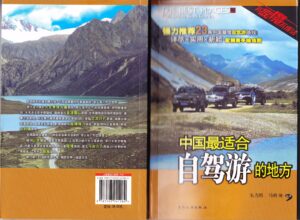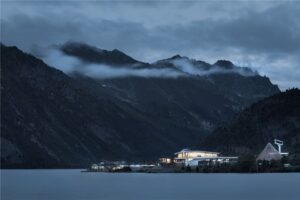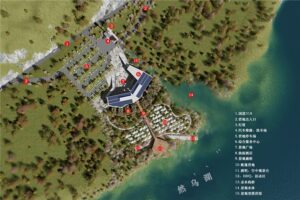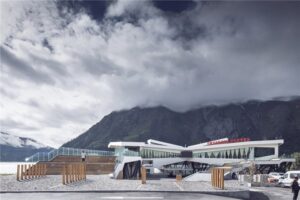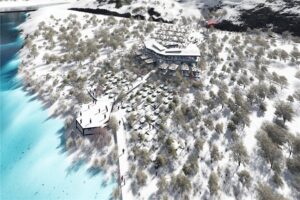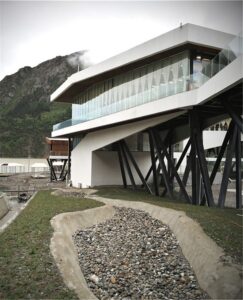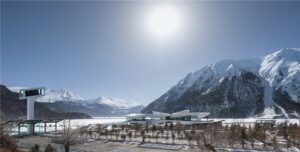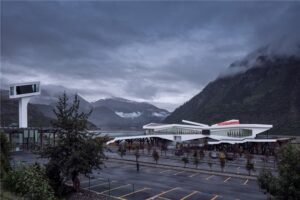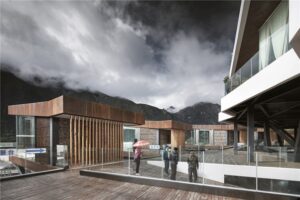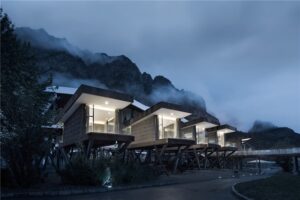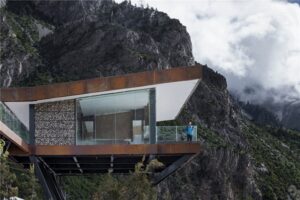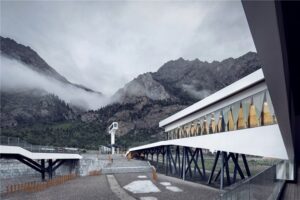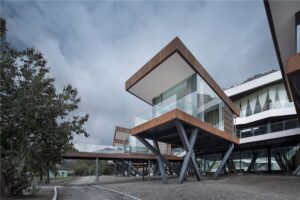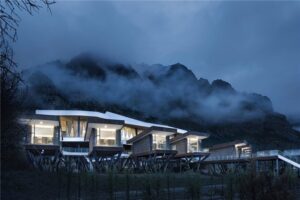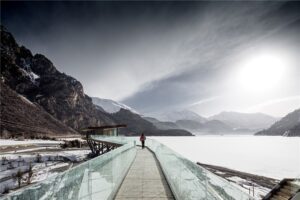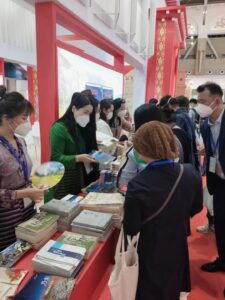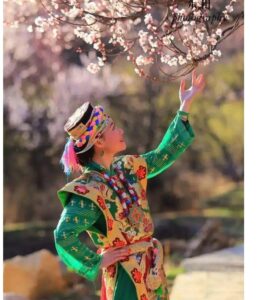NYINGTRI ESCALATES RISK MANAGEMENT CONTROL OF RURAL TIBETANS
Why would the rural police, responsible for enforcing agriculture regulations in lower Tibet Nyingtri district, be advertising for riot control gear suppliers to pitch to them? The officials of the Ministry of Agriculture and Rural Affairs (MARA) aren’t tackling a dangerous gang of cattle rustlers, or drug smugglers. Their responsibility is merely about seeds, pesticides, veterinary drugs, feed, agricultural machinery, animal and plant quarantine and prevention, agricultural product quality safety, and fishery administration. So why the 2023 advertisements for “unannounced raid forensic equipment, signal jamming shields, stab-proof undershirts, electric batons, night vision devices” and more?
Apparently the Nyingtri local rural cadres, being local, weren’t up to the task, and have been replaced by squads directly answerable to Beijing, where securitization of everything is the need of the hour, in fulfilment (or over-fulfilment) of Xi Jinping’s risk control obsessions that override all else.
As a national ministry, MARA has stepped in, complaining that “Over the years, decentralized law enforcement within local, especially county-level agricultural departments has affected law enforcement effectiveness.” That is now so yesterday. The new crack law enforcement squads under Beijing’s command, armed with night vision goggles and knife-proof vests, are now stepping in to deal with malefactors.
Is this arming of the agricultural police to do with guaranteeing China’s food security? In Nyingtri, and across Tibet, that makes little sense, since displacing nomads and taking their lands out of production only depletes food security, both for Tibetans, and in lowland China as well. What are the crimes being committed by Nyingtri farmers? What have these rogues been getting away with until now?
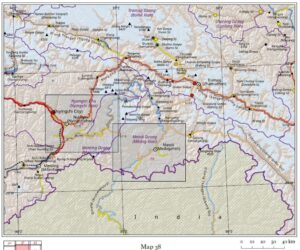
SPRINGTIME FOR NYINGTRI AND CHINA
ཉིང་ཁྲི། Nyingtri, close to the Indian border and to Arunachal Pradesh, has become a major destination for moneyed Han Chinese seeking a break from the oppressive humid heat of Chongqing and Chengdu in summer. Nyingtri is a hill station in many ways akin to what the British Raj, tired of heat and dust of India’s plains, sought in the Himalayan foothills, in Shimla, Mussoorie and Dharamsala. The Nyingtri Hilton hotel boasts a golf course, the first in Tibet.
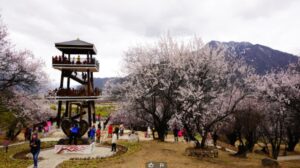
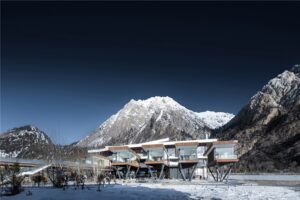
The Rawok (in Chinese Ranwe) Lake resort well east of Nyingtri town is designed for newly rich tourists, driving their new SUVs, to stay by a beautiful lake, all urban comforts supplied, a glamper destination designed by celebrity architects.
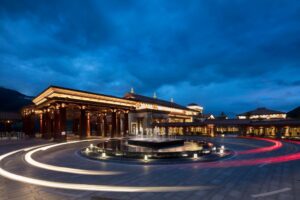
While the impulse for an elite hangout of privilege and display seems to bridge the 150 year gap, between the British and Chinese Raj, much has changed in that time, especially the definition of luxury. The Brit hierarchy were happy to parade the mall in their finest, with an eye for a dashing officer to marry off their daughter to. Today’s tuhao Han new rich are more ambitious, wanting to persist with dealmaking in fast moving markets, everywhere and anywhere, requiring strong bandwidth connectivity and low latency. They also expect to take time out, to celebrate wealth in a luxury villa surrounded by the flowering peach trees for which Nyingtri is now famous, every bit as prestigious as Japanese cherry blossom time. Nyingtri is the new Japan.
Deal making and staging banquets go together in the Chinese system, in a country where only established entrepreneurs can access bank loans, pushing all new entrants to seek their capital in the unregulated shadow banking system, which runs on bonds of trust generated in those banquets and elaborate gift-giving. Only the vulgar and uneducated would call this bribery.
Discretion is essential in these times when the centralised regime announces one crackdown after another, against its factional enemies. Discreet hotels, golf courses, exclusive SUV campsites, resorts and private villas all facilitate business with Chinese characteristics to flourish.
So whence the ag police in full riot gear? Their job has nothing to do with the holidaying bosses and their concubines. Their work is strictly all about farming. Like the gated communities of the rich in the US, the proletariat needs to be kept out, but that too is the responsibility of regular police.
Nyingtri, now accessible from Lhasa by high-speed train, has a special status. It is an artfully contrived landscape laden with Chinese aesthetics, especially the peach blossoms, which have become the iconic meme signifying Nyingtri and nearby Bayi as the place to be. Nyingtri’s climate is a big selling proposition, uniquely warm compared to the rest of the frigid, hypoxic plateau.
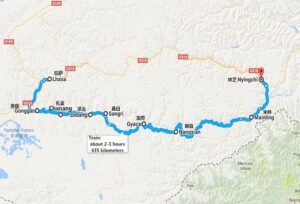
As a result there are master plans for mass tourism to Nyingtri, 中国·林芝国际生态旅游区发展总体规划 2016-2030 and 林芝市全域旅游总体规划2018-2025.
FROM INDUSTRIAL TO POST-INDUSTRIAL PARADISE
Nyingtri is an enclave of privilege and consumption, which stages its desirability across a landscape of lakes, rivers, mountains and wide valleys that were forested until Chinese loggers arrived in the Maoist decades. In those revolutionary times, Nyingtri was destined for an industrial future, a regional hub for wool spinning, Tibetan carpet manufacture and paper making based on the logging industry. These state owned industries eventually failed.
As gateway to subtropical south-eastern Tibet, and logistics hub for any fresh assault on India’s Arunachal Pradesh, Nyingtri retained strategic importance, especially Zhȏlpa Prison, where Tibetan prisoners worked at paper making. This prison-cum-state farm was not the only attempt at growing crops familiar to Chinese stomachs. The prison system was closely allied with the state farms trying to scale up agriculture that would sow and harvest crops with Chinese characteristics, in part to feed the PLA garrison town of Bayi, named to commemorate PLA Founding Day, August first. This was the task of the Agricultural Reclamation Bureau, which did, with prison labour, deforest the district, but had little success with Chinese crops. Reclamation means the work of making “waste” land, in this case forest, into usable, arable land suitable for wealth accumulation.
It was only in this century, as wealth accumulated across China, that Nyingtri emerged as a luxury destination. It is the antidote to the stifling heat of the Chengdu-Chongqing megapolis basin, where the humidity is so high you can’t sweat. Nyingtri is the pearl of Tibet. At 3000 metres, high enough to escape the polluted air of the basin below where the world’s top corporations manufacture it all, in industrial “parks” surrounding the cities. Yet, at 3000 m, Nyingtri is one of the lowest altitudes in Tibet, spared the biting cold of winter, welcoming the warm winds coming up through the Himalayan valleys from India.
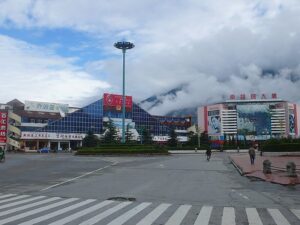
Staffing Hilton hotels, golf courses, glamping and villas is labour-intensive, attracting emigrants up from the plains, and Tibetans relocated from the uplands by decree. They are the new gig economy workforce, the cooks and cleaners, maids and delivery drivers of this new destination for displaying individual tastes and desires. Maybe they need policing? That’s the job of the regular police and if necessary the People’s Armed Police and the nearby PLA garrison.
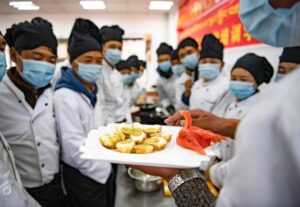
This problem, necessitating stab- and knife-rated Kevlar vests, is specifically rural. It seems some of the relocated Tibetan nomads, bussed out of the uplands, are surreptitiously keeping a few livestock, which is forbidden. The displaced drokpa are required to wholly “put down the whip”, to use a Chinese idiom 对这些放下牧鞭的 duì zhèxiē fàngxià mù biān de, that wrongly assumes drokpa ever did whip their animals. (Phun tshogs dbang rgyal ཕུན་ཚོགས་དབང་རྒྱལ། , Communicating With Yaks: Shouts And Whistles, Asian Highlands Perspectives 2019 Vol 58)
Current policy houses the displaced in model prosperity xiaokang villages designed as showpieces of party-state benevolence, where the rehoused have nothing to do, no way forward or back, dependent on state subsidies and transfer payments.
Not surprisingly, some grieve having no animals and no purpose in life, and manage to hide a few animals up the valley. They are the ones who bring down the tone of the neighbourhood, who contradict the win-win propaganda of a new utopia, of moderate prosperity for all.
New era China finds this intolerable, an affront to the mandatory reporting up the line of policy success, exemplary implementation of the official line, all in blossoming landscapes of abundance. Hence the ag police, arming themselves for battle.
MAKING NYINGTRI A ZONE OF EXCEPTION
In today’s China, the authoritarianism and security fears of the central leaders attract zealous authoritarian personalities all down the line, right down to the ag police. In Maoist times these zealots would pounce on any communard who dared to grow their own vegetables by the back door. Today the focus is on whole landscapes designed for luxury consumption. Nothing must contradict the master narrative of the peach blossom paradise, in which everyone prospers because the benevolent state provides for all.
Transgressive ex-nomads surreptitiously raising a few sheep, even a yak or two, in the hills above the broad Nyingtri valley floor, are an intolerable security risk, an affront to China’s arduous efforts at constructing ecological civilisation, and must be confronted by the full force of the law, riot shields up.
The mountains surrounding Nyingtri are scenery, a geography of idyllic perfection, the scene setter for consumption of all that makes a privileged life so special. Nothing must interrupt the illusion of pristine hills, dusted with snow as the first warm southerlies of early spring cause the plum trees to blossom in profusion. If there is a heaven on earth, this is it, not to be sullied by vagabond nomads hiding livestock upslope or in sheds, that poop in the purest of waters.
When you are out on the greens of the Nyingtri Hilton golf course, doing deals with your business buddies, the last thing you want is the thought of a recidivist rural proletariat up in the virginal hills surrounding you, unable to let go of their old animal ways.
Despite all China has done for these rootless rural labourers, they persist with their old ways, surreptitiously grazing animals on hillslopes alive with the sound of a thousand flowers blooming.
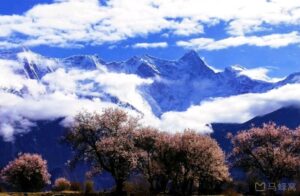
Where else in the Sinosphere is there a landscape so Shangri-la perfect? Even the officially designated Xiang-er-li-la in Yunnan is not arrayed as one of these vistas of perfection that frame Nyingtri. China is not at all bashful about appropriating the classic Tibetan trope of Nyingtri as a pure land. “Nyingtri Pure Land on Earth, Drunk on the Beauty of Nyingtri” are the two top slogans of Nyingtri tourism marketing, “人間淨地·醉美林芝”, rénjiān jìng de·zuì měi línzhī.
The landscapes of Nyingtri’s broad valley are not only Chinese, and only incidentally Tibetan, they are prime spaces for China to reinvent itself, in keeping with these times not seen in a century, as a surging nation of entrepreneurs, forging ahead, capable of inventing the new human desires that drives a post-industrial consumer-based economy. Nyingtri is an incubator of innovation, secured, and well away from the gaze of discipline inspectors. Law enforcement is focussed not on the rich but on those primitive Tibetans stubbornly persisting with a few livestock.
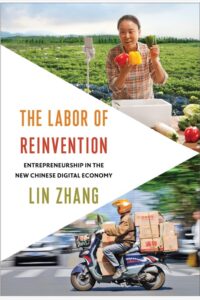 Nyingtri is a zone of exception, a liminal space for capital and the next wave of entrepreneurs to meet. Like a free trade zone, exempt from normal state regulation, Nyingtri exists in a bubble, both as a highly securitised frontier city close to the border with India, and as a frontier of possibility, for inventing the endlessly proliferating desires that power the newly emerging “dual-circulation” economy.
Nyingtri is a zone of exception, a liminal space for capital and the next wave of entrepreneurs to meet. Like a free trade zone, exempt from normal state regulation, Nyingtri exists in a bubble, both as a highly securitised frontier city close to the border with India, and as a frontier of possibility, for inventing the endlessly proliferating desires that power the newly emerging “dual-circulation” economy.
Now that financialisation is central to the flows of capital seeking both risk free security and the highest rate of return, the wealthy need venues where they can discreetly check out the promoters of the next big thing. As China continues to generate more billionaires each year, even more than in the US, accumulated capital seeks escape velocity to be safely parked in Vancouver or Sydney real estate, away from the predatory party-state. But capital unable to attain escape velocity needs to be invested in whatever is likeliest to boom next.
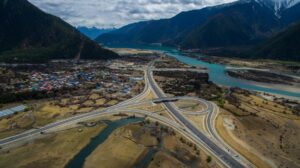
Conventionally, Shanghai is the commercial capital, along with Guangdong and Shenzhen. Nyingtri is not one of the boardrooms, it is a backroom, where it is possible to test and bond with the next Key Online Leader who has the influencer magic that will appeal to the mass market. Nyingtri is also a place from which to broadcast your immersion in being drunk on the beauty of Nyingtri.
FRONTLINE NYINGTRI
China may have a bigger agenda than rounding up stray sheep and stray Tibetans who perversely persist with the livelihoods that give them independence and dignity, rather than reliance on the party-state to subsidise their subsistence as demobilised strategic hamlet householders.
Nyingtri is the front line, where China adjoins Monyul, the Tibetan lands of the Indian state of Arunachal Pradesh. Securitising the entire Tibetan population of Nyingtri “municipality” in villages built to sedentarise and surveil them all, is a high priority. Until now, China has maintained the elaborate fiction that all Tibetan pastoralists removed from their pastures do so voluntarily, choosing to become “ecological migrants.” Recent fieldwork in pastoral districts designated for resettlement shows how coercively cadres press families to move to distant xiaokang “moderate prosperity” villages, built of prefabricated foamed concrete panels, to live thereafter under a local grid monitoring team always looking out for any aberrant behaviour.
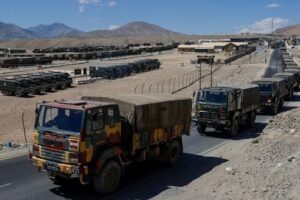
Occasionally coercion is not enough, nor the inducements of access to schooling for your children, healthcare for your elders, all of which are now so centralised they are available only in urban centres. The push of coercion and the pull of access to services do not always succeed in persuading obstinate nails from sticking up, sticking to their ancestral lands and mode of productive livelihoods.
But in a frontier district, and in an era of maximum securitisation, maybe the purpose of arming the agricultural enforcers is in preparation for the complete removal from rural Nyingtri of all nomads. Could that be what “unannounced raid forensic equipment, signal jamming shields, stab-proof undershirts, electric batons, night vision devices” are for?
China is in a hurry to implement its assimilation agenda that aims to make all minority ethnicities Chinese, loyal to the central party-state, who identify as a single Chinese ethnicity, Zhonghua. Accelerating the pace of deTibetanising Tibet is not only deemed urgent, there are now regulations formalising the process, and explicit in naming a coming phase of enforcing those regulations. Nyingtri is one of five prefecture/municipalities named as the focus of these enforcement procedures.
ENFORCING ASSIMILATION
Cadres are instructed to “conscientiously organize the implementation of the legislative planning and plans approved by the regional party committee, the development of national security, the management of ethnic affairs in accordance with the law, to promote rural revitalization. In addition, the government has also been working to strengthen legislation in key areas such as safeguarding and improving people’s livelihood, education and medical care, and to create institutional mechanisms conducive to national unity and progress through legislation. Since this year, regulations on the construction of peace in the Tibet Autonomous Region, regulations on the management of police auxiliary personnel of public security organs in the Tibet Autonomous Region, regulations on the promotion of rural revitalization in the Tibet Autonomous Region. ’Regulations’ governing law enforcement inspection were included in the annual supervision work plan of the Standing Committee of the Tibet Regional People’s Congress in March 2022.”
All local governments are now instructed “to carry out the “Regulations” law enforcement inspection. Enforcement inspection adhere to the problem-oriented, through the convening of seminars, listening to briefings, viewing archives and other ways, in-depth search for the implementation of the “Regulations” in the problems, communication and feedback on the implementation of the process of opinions and suggestions, and effectively promote the implementation of “Regulations” in the region.”
“Fostering a strong sense of community for the Chinese nation should be the main task, Wang Huning said, calling for solid progress in modernization for ethnic minorities and in areas where they inhabit.”
INSCRIBING CHINA’S GAZE ONTO NYINGTRI LANDS
The Nyingtri district was quickly identified by cadres as a landscape more favourable to intensified production, and future expansion, perhaps even immigration of Han Chinese settlers. The PLA established three state farms in Nyingtri district to trial crops familiar to lowland Chinese, in the hope that the higher rainfall and benign climate of Nyingtri would accommodate agricultural innovation. Any crops coming from the State Farms in Nyingtri –Menling, Zholpa and Nyingtri farms- would have an immediate market feeding the PLA troops garrisoned permanently in Nyingtri.
The State Farms were transferred to the management of the Agricultural Reclamation Bureau, whose task, as the name suggests, was to convert natural landscapes into arable, human landscapes which, in Nyingtri, mostly meant logging the surrounding forests.
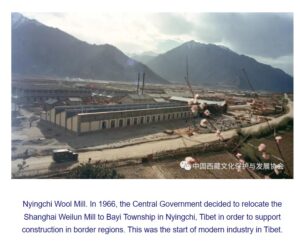
But, as elsewhere in Tibet, cropping with Chinese characteristics produced very limited results, even though agronomists had forecast several possible new crops, and agroindustries based on them.
Nyingtri was also the base of attempts to industrialise the manufacture of finished goods made from Tibetan raw materials, especially the abundant oversupply of wool. The Nyingtri Woollen Mill was intended as an exemplary state enterprise that would not only produce Tibetan carpets in demand elsewhere in China, but also become a model for further industrialisation. The woollen mill was another PLA enterprise, for an army in need of woollen coats to fight in Korea. Again, the Nyingtri Woollen Mill never lived up to expectations.
More successful was Bayi, the new town established from scratch, in Nyingtri district. Bayi means 8-1 in Chinese, in homage to the People’s Liberation Army founding anniversary, and was the first completely new town in TAR. 8-1 started as a State farm, largely worked by prisoners, almost all of them Tibetans who had been declared “class enemies” in the compulsory process of “speaking bitterness” and denouncing landlords and teachers. 8-1 was actually a chain of state farms in many districts of TAR, with Nyingtri the longest lasting.
A 1999 article declaring Nyingtri Woollen Mill a success names production output, at quite modest levels: “The mill was set up in the late 1960s, and originally had about 800 workers, with an output of 60,000 meters of woollen cloth. At present, the mill has seven workshops, over 1,600 workers and produces not only woollen cloth but also knitting wool and carpets, with an annual output of 400,000 meters of woollen cloth, 400,000 kg of knitting wool and 20,000 carpets.” Compared to Tibetan carpet production in Nepal, this is not big, even if, in the manner of state enterprises, it had a huge payroll.
There was a paper mill in Nyingtri, attempting to add value to the logging of nearby forests, which also failed.
More reliable enterprises have been based on Nyingtri as an essential truck stop on the long haul highway logistic chain between major lowland cities such as Chengdu with Lhasa. Almost everything needed for modern administrative control had to be trucked in, on highways prone to landslides, on trucks not designed for steep gradients and, in the 1960s and 1970s, underpowered and straining uphill, in need of many repairs to keep them on the road.
RIOT SHIELDS IMPOSE CIVILISATION
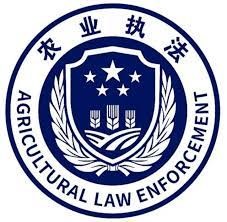 Is it really believable that a newly empowered rural police force could be so petty, and so fixated on securitising everything, that they arm themselves with full riot control gear in order to control a few displaced nomads who persist in keeping a few cattle?
Is it really believable that a newly empowered rural police force could be so petty, and so fixated on securitising everything, that they arm themselves with full riot control gear in order to control a few displaced nomads who persist in keeping a few cattle?
The wider picture is that such micro-managers of the uncivilised rural folk are popping up everywhere, not only in Tibet, and their mission is to impose civilisation.
This is the authoritarian mind busily at work, imposing order, hygiene and urban concepts of civilised behaviour of the disorderly rural masses focussed only on getting the next crop in the ground, who don’t much care if they dry their quilts in their yards, or sunbathe at home when taking a break, or grow extra vegetables for their own consumption; all of which are examples of what is now being cracked down on by the new “agricultural management law enforcement officers” 农业管理执法人员, nongyè guǎnlǐ zhífǎ rényuán.
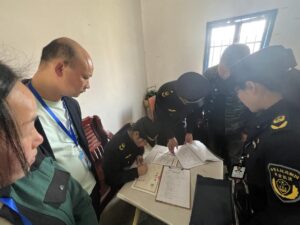
To the orderly mind rural life is so disorderly, so suspiciously reliant on variable weather, so prone to hawking, spitting and even urinating wherever, so unhygienic, so behind the times, a drag on national success. Worst of the worst are those skilled at living off uncertainty, which is how nomads adapted to the climate extremes of Tibet, ever willing to move on with their herds, to avoid over-grazing that threatens the grasses.
So totally has urban elite China misunderstood the mobile pastoralism of the Tibetans, it sees only uncivilised, animal-like, primitive subsistence at the mercy of nature. The contempt of urban elites for the rural masses is not new, but in this New Era it is more contemptuous than ever, masked by grand slogans on the need for suzhi, human capital formation, and the arduous struggle to construct ecological civilisation.
The straight lines of the mass spectacle squares and avenues designed for military parades, carved out of the laneways and court yards of old Beijing, are what appeal to the authoritarian minds of the rise and rise of China. Their bulldozing of the hutongs inspires utopian visions of a new urban paradise on earth, which in turn becomes the model for rural China to aspire to.
The need for agricultural management law enforcement officers to enforce order derives its model from the authoritarianism of the urban chengguan, local neighbourhood police of urban China, who chase away street sellers and anyone not from the immediate neighbourhood, who by definition are deemed a security risk.
Extending urban discipline to rural areas extends the reach of the state into all localities, ensuring uniform compliance with standards of civilised behaviour that supposedly propel China forward. In keeping with New Era orderings, the coercive powers of agricultural management law enforcement officers are codified, in a decree of December 2022 issued by the Ministry of Agriculture and Rural Affairs. This notice details which uniforms are to be worn, by whom, and when. Article 28 guarantees their impunity: “The comprehensive administrative law enforcement personnel in agriculture shall be protected by law in the performance of their statutory duties, and shall not be subject to disciplinary action for reasons other than those provided by law or by legal procedures. No organization or individual shall obstruct or hinder the comprehensive administrative law enforcement personnel of agriculture in the performance of their official duties in accordance with law.”
Agricultural management law enforcement officers may, like urban police, equip themselves with coercive gear: “Article 33: Local people’s governments at or above the county level, agricultural and rural authorities should be equipped in accordance with the relevant law enforcement equipment standards for comprehensive agricultural administrative law enforcement agencies with the basic equipment required to perform their duties, forensic equipment, emergency equipment and personal protective equipment and other law enforcement equipment.”
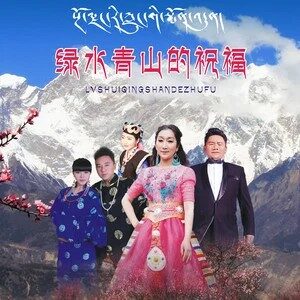
While the privileged talented elite are at the forefront of ensuring China continues to grow, all citizens are required to improve individual conduct, engage in self-criticism and embark on an improvement program, with emphasis on virtue and responsibility. This is the patriotic duty of all. So punishing backward pastoralists for persisting with their mode of production is just the start of becoming modern, civilised and a contributor to making new era China. [1]
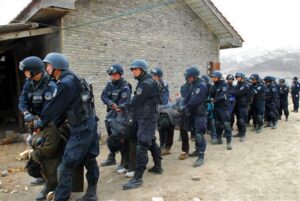
For China to move forward with maximum momentum, all that is backward must be liquidated. China’s mission includes the explicit goal of attaining the rate of urbanisation of the richest countries. Conventional market economics also supports further urbanisation, because densification of cities achieves economies of scale that make delivery of services more efficient, and profitable for the construction industries. So China “continues on a decades-long, erratic, but relentless mission of development…. To convert even the remotest regions from subsistence to market-based livelihoods… and to improve the ‘quality’ of its population by giving them education, health care, and opportunities to participate in the modern industrial economy…. Three aspects of the development process -conservation, education, and migration- are all connected by a basic logic of development, the idea that poor, peripheral, or even just ethnic minority regions suffer from lack. They lack income and the amenities of modern life…. Because the local people are ignorant of science, they do not know how to manage their environment, so the state must step in and be conservationist, imposing reforestation, payment for ecosystem services programs and protected natural areas. Both because they are ignorant of science and lack the spirit of innovation, the state must step in and provide education to change their backward attitudes.”[2]

Tibetans coercively relocated to Nyingtri, who stubbornly attempt to maintain their customary livestock livelihoods, are thus to be treated as criminals who refuse the national agenda of compulsory modernity. They have been instructed to “put down the whip”, yet surreptitiously keep a few animals in the hills, for subsistence. They are refusing modernity, refusing to abandon the use economy Marx so admired, to instead enter the exchange economy which Marx abhorred as exploiting the labour of the actual producers.
Tibetan pastoralists bussed down from the high pastures should, in the eyes of the party-state, be grateful to be given opportunity to enter the instrumental market economy, for their children to learn Chinese, the language of modernity and science. Instead recidivist ranchers deeply miss living with animals that used to overwinter together, the beasts huddled against the cold on the ground floor, the nomad family above.
Those green-brained Tibetans fail to see the new opportunities available as they enter history, entering the market economy in a municipality brimming with service industry employment, such as hotel maids, golf green maintenance, villa cleaners, construction workers on sites where more luxury accommodations are rising.
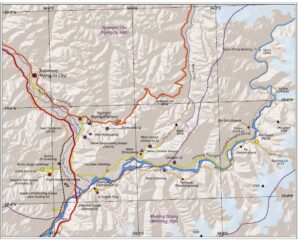
Nyingtri has a special status, as a municipality that has dropped all mention of being nominally autonomous, in which an indigenous minority has special rights. In the annual Tibet Autonomous Region Statistical Yearbook, Nyingtri sits between Chamdo prefecture and Lhoka Prefecture. (Shannan in Chinese). Nyingtri now includes the subtropical hidden lands of Metok, Kongpo, Pome and Zayul, a substantial area, much warmer and wetter than most of Tibet.
The 2021 TAR Yearbook lists the Nyingtri rural workforce as only 72,000, of whom 3,200 work in construction, 58,000 in agriculture, forestry and animal husbandry. Nyingtri is a large area, similar to England, its terrain rugged, its climate conducive to production not possible in most of Tibet. Before the People’s Liberation Army marched in, it was known for its millet rather than the barley grown in Tibet. “They used their millet to make flour and beer (a particularly cherished blessing of Guru Rinpoche and the goddess). They also grew fruits and vegetables – bananas, star fruit, sweet potatoes, brinjal, ginger, chilies, pumpkin, cucumber, and peas – and raised pigs, chickens, and cows.”[3]
Revolutionary China militarised production of these crops, in state farms established to feed the occupying troops dug in to their garrisons to quell any further protest. Militarised farms are not a new idea, they have a long history, integral to China’s colonization of southwest China long before seizing Tibet. Usually, they encouraged landless peasants to migrate to the new frontiers, with the army a guaranteed buyer of their farm crops, grown under the protection of the occupation force.
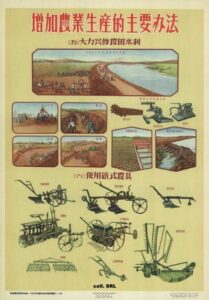
From the outset, revolutionary China attempted a similar strategy, expanding the crops to include tea, peaches, melons, apples, almonds. Three large state farms attempted to scale up production, modelled on the Xinjiang Production and Construction Corps of demobilised PLA soldiers, brought in to subtropical Tibet to kick start intensive production.
However these three state farms faltered, for the same reasons as elsewhere in Tibet: lack of labour. While most of Tibet was too hypoxic and too cold for Han peasants and Han farming, this most southerly portion of the plateau was too remote, too wet and too beset by endemic insect-borne diseases. Revolutionary enthusiasm waned, the state farms failed, later revived by fresh injections of capital under the “aid Tibet” program of the 1980s and 90s, in which wealthy provinces of eastern China were required to assist Tibet industrialise. The most recent investments have gone into mechanising and automating production, the modern way of bypassing labour supply problems.

So the three state farms still exist and are listed in the TAR Statistical Yearbook separately from the counties that comprise Nyingtri. Their output is modest, one is still owned by a state-owned corporation that specialises in operations saddled with unrepayable bad debt.
These experiments in commodification of the abundant farming opportunities not only sought to industrialise agriculture but establish a hierarchical, semi-military, command and control model that persists even now. From the outset, the state farms were about mass production, efficiencies of scale, with the human labour of Tibetans at best just one of the factors of production.
Given that as the model to be emulated, Tibetan herders continuing to herd a few animals, are transgressive in multiple ways. The legally binding agreement signed by open range livestock producers when they surrender their land tenure and sell their herd, forbids them, on resettlement, to resume grazing. That alone makes them criminal, for persisting on a modest scale, with the only mode of production they know so well.
But the criminality of herders herded into the model xiaokang moderate prosperity villages of Nyingtri district goes beyond breaking the no livestock rule. The livestock they do keep are not for the market, but for subsistence, in a use economy. This too is subversive, and warrants criminalisation.
Industrial agribusiness, whether owned by state farms or private corporations, is the model, even though the biggest outputs are tea and pork, and pork mass production requires refrigeration and cold chain logistics that only now are being built.
Although Nyingtri is classified as a municipality, its area is 116,000 sq kms, and the administrative head office is Bayi, a military city close to Nyingtri town, its name and origins purely military, commemorating the day the PLA was born, 1 August. Today, Bayi dominates both the economy and the politics of Nyingtri, while nearby the broad valley where great rivers meet, is the paradise of the leisure class.![]() The three state farms are in very different terrains, with markedly differing climates. The geobody of Nyingtri municipality is designed to include the whole of the Yarlung Tsangpo after it leaves Lhoka Shannan) until it reaches India.
The three state farms are in very different terrains, with markedly differing climates. The geobody of Nyingtri municipality is designed to include the whole of the Yarlung Tsangpo after it leaves Lhoka Shannan) until it reaches India.
MENLING STATE FARM
Menling state farm (Milin in Chinese) is even closer to the border with India than is Nyingtri town. It boasts of being “the largest fruit industry base in Tibet….and a leading enterprise of agricultural industrialization production and operation.” Baike baidu website, a Chinese Wikipedia, has a detailed history, from its start as a feed-the-troops and reclaim-waste-land under “troop-style management, with a chief, political commissar, company commander, instructor, platoon leader, squad leader and so on.” It is frank about the failures: “Cultural Revolution, an unprecedented catastrophe, caused serious losses to the cause of reclamation. Organizations at all levels were paralysed, workers were in disarray, some of the farms were abandoned, and fruit forests suffered damage.”
The tail end of the fixed price centrally planned quota system was good for Menling: “From 1987 to 1992 was the most glorious period of Milin farm. After 1992, with the planned economy to the market economy of the transition, the economic benefits of the farm decline, the life of workers increasingly difficult, the enterprise began to lose money.”
Eventually the Menling state farm was modernised, deploying capital investments by wealthy eastern provinces: “ten large projects sixteen sub-projects all completed. Successively built the Tibet Linzhi style hotel, high agricultural demonstration park, dried apple processing plant, farm LAN, high-quality seedling breeding base, park orchard road hardening, Yajiang leisure cabins, cellar preservation storage, frost-proof smoke stove and other infrastructure construction. Especially, the construction of high-quality agricultural park and high quality seedling breeding base has played an irreplaceable role in the formation and development of fruit industry belt in Linzhi area, with remarkable radiation and driving effect.
“July 2010 – present, introduction of aid funds 20.5 million yuan, focusing on the construction of green corridors, the old apple orchard transformation, Yajiang sightseeing orchards, the transformation of dilapidated housing for workers, the plateau quality fruit marketing centre, fruit refrigeration and fresh storage, human drinking water project, the autonomous region of agricultural and livestock industry industrialization business.”
Livestock industry industrialisation is now the way ahead, in contrast to the fugitive rearing of animals in the hills, by exnomads distressed at losing their livelihoods. Nomads go to where the grass is; civilised folks pen the animals in feedlots and bring forage to them.
The operationalisation of the Nyingtri-Lhasa high speed rail line means there is now a market for new products: “Now we have grapes, nectarines, peach, apricots, plums, walnuts, apples, watermelons, melons, strawberries and other fine varieties adapted to the growth environment of the plateau, with an annual output of about 2,000 tons.”
POME YIGONG STATE FARM
The Yigong state farm, focussed on tea plantation and red tourism, seems more successful, well further east, in Pome county. Tea, once dried, is far less perishable, and Tibetans drink a lot of tea. Tea can be not only packaged but marketed and branded. But the first step, to get Yigong out of bad debt status, is to mechanise: “pay close attention to the whole chain of Tibetan tea industry level upgrade. Yigong tea farm party secretary Cao Yutao explains that through “eliminating a number of, upgrading a number of, adding a number of” upgrading project, has introduced the first Tibetan colour sorter, automatic brick tea pressing machine, automatic tea picking machine and a number of advanced equipment, improve the tea production and processing process, launch a new series of 32 new products mainly for high quality and high-end Yigong tea field, promote Yigong tea field from the traditional The tea factory has been transformed from a traditional manual production to a modern tea production enterprise.”
Cao has also energetically promoted the tea gardens as a patriotic red tourism destination: “To strengthen the red history and culture of the tea field, strengthen the red ideological education and learning, innovative party building propaganda model, multi-format party day activities and red education and practice activities and other ways to gather the strength of the staff. Fully excavate the red history and culture of the tea field, grasp the Yi Gong tea field compilation work, inherit the red gene, tell a good red story, create a red atmosphere, cohesive workers to the party, to the heart of the tea field. And for the YiGong tea field developed a set of highland ecological agriculture demonstration brand park, patriotic education base, special tourism resort area as one of the red tea travel ecological town master plan.”
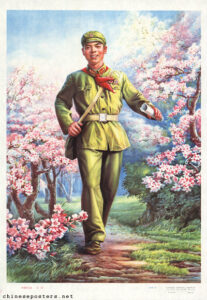
ZAYUL STATE FARM
The most remote state farm is Zayul, 600 kms east of Nyingtri, yet still under its municipal jurisdiction. The Zayul State farm has a troubled history, despite its promising climate, which can inevitably be blamed on those backward Tibetan pastoralists and their low level of civilisation.
China’s State Farms platform www.farmchina.org.cn provides a history of this long experiment with reclaiming the hidden pure lands where Tibetans go on arduous pilgrimage to purify the mind, taking in their stride the many risks of mountainous semi-tropical jungle.
Zayul State Farm seemed a great location “about 18 kilometres from the actual control line of the Sino-Indian border, altitude between 1300 – 1700 meters, a subtropical river valley climate. The farm is located in the lower Tsum area with warm winters and hot summers, moist and rainy all year round, with an annual rainfall of 1000 mm, an average annual temperature of 17℃, and 1680 hours of sunshine per year, suitable for planting all kinds of economic crops.”
The location seemed auspicious, less so the timing, as in 1965 Cultural Revolution was about to break out. Only three years earlier the PLA had invaded India, capturing Arunachal Pradesh, then withdrew. Zayul State farm was part of making permanent the militarisation of the frontier zone. “Tsatsumi [Zayul] farm was built in March 1965, was the troops responded to the Party Central Committee proposed “development of the frontier, the construction of the frontier” call to settle the frontier, by the border troops as a whole to the establishment of military farms. 1965-1978 belonged to the Tibetan Military Region Production and Construction Division 404 troops border six regiments, the management system for the troops. From 1978 to 1983, it was transferred to the jurisdiction of the Department of Reclamation of the Tibet Autonomous Region.”
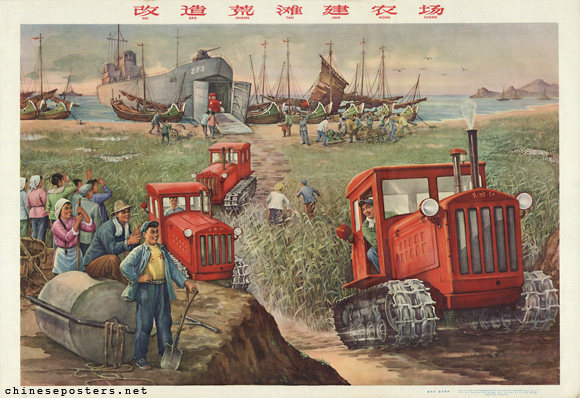
RECLAIMING WASTE LAND
In the absence of Han emigrant settlers, amid the indifference of the local Tibetans, and the amazement of Tibetan pilgrims, the soldiers-cum-farmers tried to “reclaim the waste land” of landscapes Tibetans see as earthly paradise, pemakȏ. Many crops were trialled, but the most promising is pigs. Tibetans have little appetite for pork, but colonial settler do.
“The farm has a party committee with 46 party members. The farm has a total population of 326 people, 177 cadres and workers (including 3 aid Tibetan cadres, 2 local cadres, 42 working employees, 130 retirees) and 15 temporary workers. The main farm to pig breeding, tea planting, but also planted with oil trees, citrus, loquat and corn, peanuts, and sporadic planting of peppers, sweet potatoes, rapeseed.”
The State farms portal is frank about the difficulties: “Analysis of problems: the farm professional and technical personnel and the lack of surrounding industrial workers….. the skill training for the surrounding farmers and herdsmen is a long way to go, and the gorgeous transformation of traditional farmers and herdsmen to modern industrial workers must be achieved over a long period of time and with great effort………….Many project announcements were rushed to start, the necessary scientific proof of industrial projects, the appropriate scale, program feasible, follow-up management, benefit linkage can not do accurate planning. Pre-project demonstration is not sufficient, project construction procedures are not perfect, project management is not standardized; such phenomena exist in large numbers. Part of the project foresight is not enough, such as pig farms, after the completion of a certain scale, before embarking on sewage treatment and manure methane capture treatment projects. Part of the project planning and construction is too far ahead, such as the completion of the agricultural packaging and processing centre, due to the lack of front-end products, resulting in the project resources idle.”
The bottom line for this top-heavy hierarchical state farm is that the Tibetans just don’t think commercially and are not interested in raising pigs solely for slaughter. Under the current 2021-2025 14th Five-Year Plan a lot more money is pumping in to rectify past failures, a total of RMB 221 million. The aim is to up the pig slaughter rate to 10,000 a year, with “the new meat refrigeration storage centre project, the main construction content of the new 2,000 square meters of two-story frame structure of the meat refrigeration storage; packaging equipment: refrigerated storage, refrigerated trucks.” Remoteness did not prevent pandemic infections from killing pigs in Nyingtri in 2019.
All three state farms manage to persist, due to recent massive external inputs from afar. What they fail to manage is their workforce, since state capitalism with Chinese characteristics reduces formerly independent livestock producers to poorly paid insecure employment at the bottom end of strictly vertical hierarchies. State capitalism lingers on, as a strategy inherent to frontier construction, with markets for their produce a secondary consideration.
Their six decades of existence give the state farms prominence in Nyingtri prefecture -now a municipality- that is rapidly evolving away from state capitalism and into consumer driven luxury consumption for the rich and famous. The economic model is changing, yet both the old command economy and the newer leisure consumption economy are alike in relegating Tibetans to menial roles, as outsiders in their own land, paid poorly to toil on their lands appropriated by colonisers.
Six decades of blaming Tibetans for being backward is, in Nyingtri, a deep backstory inherited from the state capitalist State Farms era, now yet again brought back from the dead by the most recent wave of frontier securitisation subsidies.
In this wider context, of six decades of turning independent pastoral producers into lumpen rural labourers, the arming of the “agricultural management law enforcement officers” 农业管理执法人员, nongyè guǎnlǐ zhífǎ rényuán, is not so inexplicable. Tibetan nomads ordered to “put down the whip” must now themselves be whipped into compliance by agricultural riot police in full combat gear.
In those six decades, some Nyingtri industries have disappeared almost entirely. The modern history of Nyingtri includes many industrial failures. In 2020, production of sheep wool in all of Nyingtri was merely 8.6 tons, with goat wool a further 1.4 tons.[4] This is a dramatic decline, as Nyingtri was the location of a woollen mill intended to not only clean and spin wool on a large scale, but also weave carpets.
No cadre of the revolutionary era, well trained in Marxism, ever explained to Tibetan landscape and livestock managers that they had created a use-value economy, in contrast to the exploitative capitalist exchange-value economy. Instead, Tibetan producers were told they were slaves of a feudal serfdom system, even in remote Nyingtri, far from Lhasa.

In Marx, in Capital, the difference is explained. Marx distinguishes between the use-value and the exchange-value of the commodity. Use-value is inextricably tied to “the physical properties of the commodity” (p 126); that is, the material uses to which the object can actually be put, the human needs it fulfills. In the exchange of goods on the capitalist market, however, exchange-value dominates: two commodities can be exchanged on the open market because they are always being compared to a third term that functions as their “universal equivalent,” a function that is eventually taken over by money. Exchange-value must always be distinguished from use-value, because “the exchange relation of commodities is characterized precisely by its abstraction from their use-values” (127). In capital, money takes the form of that equivalence; however, money in fact hides the real equivalent behind the exchange: labour. The more labour it takes to produce a product, the greater its value. Marx therefore concludes that “As exchange-values, all commodities are merely definite quantities of congealed labour-time”.
China has cycled through the Marxist promise of a utopia in which all receive according to their needs, to the capitalist entrepreneurial utopia of gig working for the tech boss, in the hope of some trickle down. China has traversed the full spectrum of political economy, with one constant: the Tibetans are primitive outsiders, in their own land. Now the Tibetans of Nyingtri, whether locals for many generations, or the recently displaced, are incidental gig workers in China’s complete embrace of neoliberal capitalism.
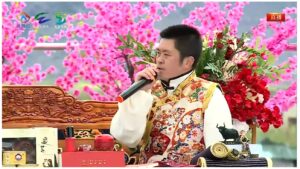
WASTE LAND TO PURE
LAND
Of all the metaphors China uses to define Nyingtri, especially its mountain clad jungle lowlands, it is now a pure land, China’s efforts to log it and farm it notwithstanding. The pure land, of Tibet in general and Nyingtri especially, has become the brand applied to all products from Tibet in the Chinese consumer market. Pure land branding enables produce from Tibet to sell at premium pricing, increasing incomes for Chinese entrepreneurs selling Tibet.
The official slogans, endlessly repeated and often run together are 人间净rénjiān jìng and地 醉美林, dì·zuì měi línzhī. The second slogan evokes the rhapsodic poetry of T’ang dynasty poets Li Bai and Du Fu, who many centuries ago immersed in mountains and rivers, and their drunken verse has been popular ever since. This is an eloquent way of making Tibetan landscapes Chinese, since the original inspirations in China have long succumbed to industrialisation. The slogan that always comes first brands not only Nyingtri, but also a wide range of products including meat from Tibet, and bottled water. Purity as a unique selling proposition (USP) is a powerful trope among Chinese customers who have had good reason to doubt the purity of foods sold to them and to their children.
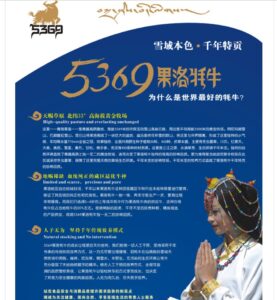
Of all the many appropriations, or thefts of intellectual property of the Tibetans, the use of “pure land” as a brand is perhaps the most shameless, since Tibetans have long seen the wild lands of lower Nyingtri as hidden lands and pure lands that purify the mind, if one undertakes a difficult and risky pilgrimage in the right state of mind.
“It is described in Tibetan literature as a difficult land of high passes, inaccessible ravines, blizzards and high winds, full of insects, snakes, leeches, and frightening shadows and apparitions. As a pilgrimage destination it is notoriously challenging, the journey treacherous, and narratives of pilgrims and explorers to the region recount series of difficulties. From what the tradition would consider a pure visionary perspective (dag ngang) of realized Buddhist masters and gter ston, those who discover and compose guidebooks to hidden lands, these powerful places are also represented as especially conducive to meditation, and they are understood to be places where spiritual accomplishment blossoms naturally. Pilgrims are reminded that Buddhism has tamed the indigenous gods and spirits. Next they learn that the holy place was fortuitously opened by a tantric adept who “opened the door of the holy site” (gnas sgo phye ba), often with divine guidance in a dream or vision. To transform it into a suitable pilgrimage place, the site is ritually consecrated, and the pilgrimage pathways and sacred power spots are then described in written pilgrimage texts.”[5]
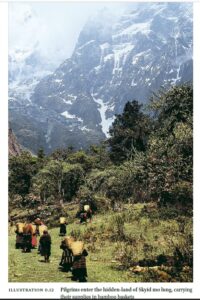
While Tibetans perversely resist becoming modern factors of production, Chinese see Nyingtri as a stage where it is possible to reinvent the self as entrepreneur. What China now worships, even more than in America, is the self-made entrepreneur. As Lin Zhang says: “anyone can be an entrepreneur, but it is incumbent upon individuals to reinvent themselves—that is, to leverage their unique backgrounds and social networks to ride the tidal wave of technological progress. Yet, in touting the universal accessibility of entrepreneurship while ignoring the inherent structural unevenness of contemporary global capitalism, advocates are perpetuating the system’s inequalities while offloading the burdens of labour reproduction onto individuals. This has deepened inequalities along gender, class, and geographic lines, as well as between mental and manual laborers. And in many respects, including pursuing financialization, building scientific infrastructure, and promoting IT entrepreneurship, China has closely followed in America’s footsteps.”[6]
AS WITHIN, SO WITHOUT
China has managed to evert this inward journey, making it into a product brand name, for launching the wealth accumulation aspirations of Chinese entrepreneurs drawn to these lands as fresh monetisation frontiers.
Nyingtri is the space for experimenting with an entrepreneurial persona. If you can make it in Nyingtri, you can make it anywhere. Finding a persona suited to the times requires much experimenting. “Schools like Beida [Peking University] are currently producing ‘exquisite egotists, who are sophisticated, worldly, thoughtful, good at playing a role, good at fitting in, and even better at using the system to pursue their own goals. By exquisite egotists, I mean egotists who have been skilfully dressed up or even disguised.” [7] So says Qian Lichun, a former Beida professor.
If you lack the right connections to get in to Beida, where can you learn to remake yourself as an influencer, a key online leader 主要在线负责人, a charismatic entrepreneur, a unicorn promoter people flock to? Nyingtri is one such stage.
You can start by doing what everyone does in Nyingtri, take lots of selfies of self with peach blossoms all around you. That iconic image displays you are a person with taste, you are discerning, civilised, uplifted by beauty, even if the Nyingtri peach blossom fetish imitates Japan’s cherry blossom promenading, and Nyingtri is now so accessible the masses are taking selfies alongside you.
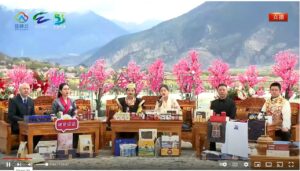
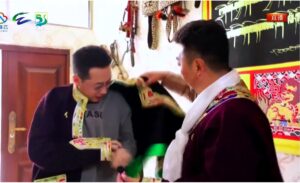
To become an outstanding entrepreneur, more is needed. Nyingtri is a launchpad for entrepreneurs who have turned Tibetan culture into merch. Influencers spruik all aspects of Tibetan civilisation that can be monetised, whether it is mandalas, handmade tsa tsa, herbal fragrances taken from sowa rigpa, indeed the merch on display is many brands, ready to take home to display your adventure and your tasteful acquisitions.
 The Nyingtri valley is a self-drive showroom , wander at will, there’s a checkout nearby. Gone are the days of herding busloads of tourists into the cloisonne factory, no-one allowed back on the bus until they have made a purchase, the commission on which the tour guide depends. China is richer, the merchandising opportunities are greater, the spaciousness of the Nyingtri valley more capacious than the crowded Lhasa Barkor.
The Nyingtri valley is a self-drive showroom , wander at will, there’s a checkout nearby. Gone are the days of herding busloads of tourists into the cloisonne factory, no-one allowed back on the bus until they have made a purchase, the commission on which the tour guide depends. China is richer, the merchandising opportunities are greater, the spaciousness of the Nyingtri valley more capacious than the crowded Lhasa Barkor.
This is modern hands-on “experience tourism”, making your own sacred symbols of indestructible purity with your own hands, from Tibetan clay, and drying them out as permanent mementoes back in your lowland Chinese city. From a state policy perspective this is “what local officials call a ‘bio-culture’ model whereby areas of biological interest are combined with the traditions and customs of the minority nationalities.”[8]
This conflation of Tibetan landscapes and Tibetan culture as fungible assets is not new. Earlier, when exploitation of Nyingtri forests and wool were the priority, the labour of Tibetans in cutting forests, making paper from wood pulp, growing the sheep for wool, was foundational for achieving the goal of industrialisation.
Now the goal has changed, but not the biocultural method of combining Tibetan landscapes and Tibetan civilisation as factors of production for China’s benefit. The goal has shifted from industrialisation to a post-industrial tourism consumption economy. The method, of combining landscape and visible local culture, persists.
Experience tourism drives another major segment of the Nyingtri tourism market, the self-drivers. Whether you are rich enough to own an SUV truck or rent one for the specific purpose of driving across Tibet, this is a fast growing market, yet again in imitation of the US and other settler colonial countries with big territories.
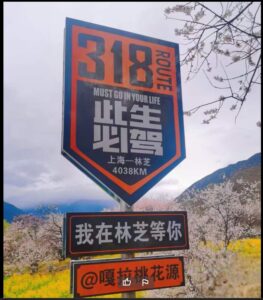
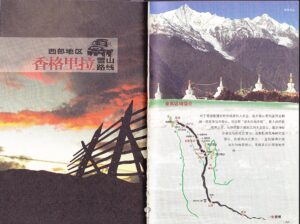
The self-made entrepreneurial man manifests his individual selfhood behind the wheel of his SUV, re-enacting the pioneering travels of the revolutionary heroes who first made these remote landscapes Chinese. Following in the path of the PLA troops hauling artillery to bombard Tibetan monasteries, and the geologists who located and named the first mineral deposits, today’s self-drive tourist expresses his patriotic red gene. In recent decades glossy tourism magazines and famous photographers such as How Man Wong have been popularising the macho reconquest of Tibet by four-wheel drive. Camera crews retrace their expeditions, enabling the stills of books and magazines to become videos. Now fast multi-lane highways are built, but the romance remains.
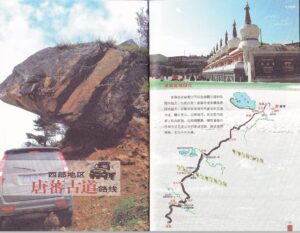
Today’s self-drive heroes, often with the family on board, need plenty of fun things to do en route and at the destination. The highways now are fast, yet still dangerous. Another market, quite different to Lhasa, opens. Tibet is a big land, Nyingtri is a wide valley, plenty of room for a sprawling SUV park with all modern conveniences. Another entrepreneurial opportunity nailed. Rawok Tso (然乌中湖, Ránwū Zhōnghú in Chinese) is on the main highway from Sichuan, easily accessed, yet remote, roughly half way between Pome and Zayul, and quite close to the Indian border. The modern economy, consuming the sublime, has arrived, another entrepreneurial first mover opportunity snapped up. The Tibetan Plateau has plenty more.
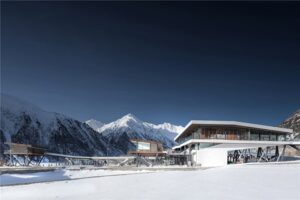
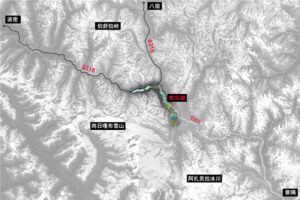
Not only is this a new market tapped, it is a big step away from the mass domestic tourism that overwhelms Lhasa, a conveyor belt of airports, railway stations, buses, hotels and fixed itineraries of groups following the tour guide’s flag. Tourists remain in a Han bubble throughout. China’s agenda, at the highest level, is to cultivate the high-quality talent of individuals, and tourism is a syllabus of individuation, teaching tourists to become discerning travellers, with tastes and preferences and the selfie pics to prove it.[9]
Experience tourism means much greater interaction between Tibetans and the Han Chinese tourists. No longer are Tibetans only maids, cleaners and construction workers building the next hotel. Now they are the floorshow too, dancing, singing, encouraging drinking, doing the product placement influencer pitch, selling all manner of branded Tibetan goods as health tonics famous for being so clean and green. The merging of Tibetan landscapes as marketable assets with Tibetan merch sold by Tibetans performing Tibetan-ness into a singular user experience.
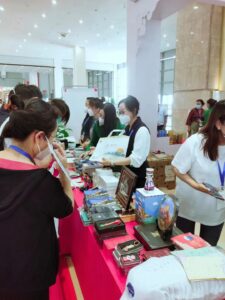
What customers experience is immersion in all that is attractive about Tibet: the beauty of landscape and peach blossom, the availability of branded products and the smiling Tibetans showing you how to wear a chuba, how to flick an offering to the gods with your forefinger before you drink. For the Tibetans deployed as dancers and sales staff, the commodification of Tibetan welcomes, gestures, sociability, are performative stagings of Tibetan tradition, so decontextualised as to have lost meaning. As authentic replicas 真品复制品 of Tibetan rituals, their purpose is solely to close the sale of a product branded and packaged by Chinese manufacturers and marketers, as authentic essence of Tibet.
To dualistic Westerners, the concept of authentic replica sounds like an oxymoron, a contradiction, at worst fakery. To Tibetans, more accustomed to a flexible, contextual fluidity of self, their required performance of Tibetan-ness may not be an insult to an essentialised identity, but it is boring, meaningless, repetitive gig economy work. For Han Chinese, the authentic replica is not at all problematic. Qing dynasty emperors built a mini Potala north of Beijing, alongside other replicas of iconic architecture of the empire the emperor would never go to, in situ. Today’s authentic replica duplitecture copysites are widespread and popular. There is a huge library in Tianjin where most of the books on display are fakes.
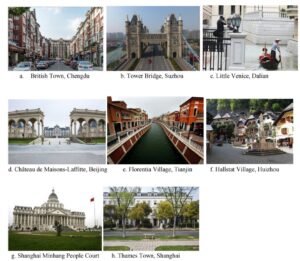
“Imitation of Western architectural iconography is rapidly making its way to China’s urban frontiers. Paris’s emblematic Eiffel Tower has a duplicate at Tianducheng, which is in Hangzhou, Zhejiang province. Australia’s most notable icon, Sydney’s Opera House, has a copy in Beijing. Similarly, there are imitations of other landmarks, such as the Roman Colosseum, Moscow’s Kremlin, Venice’s canals, and replicas of ancient towns and cities across China. Some of the replicas in China were originally built as part of the so-called “theme parks.” For instance, Lanzhou, a city in the North-western China’s Gansu province has gigantic replicas of Athens’s iconic Parthenon and Egypt’s Great Sphinx of Giza; these were under the Silk Road cultural relic project theme park to boost the tourism industry of the city.”[10]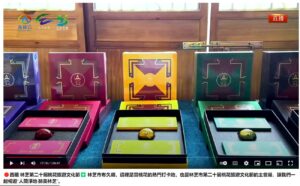 In Tibet, the authentic replica, zhēnpǐn fùzhì pǐn, is seldom architecture, and more commonly a simulacrum of Tibetan dance moves, mudras, sowa rigpa herbal tonics and the symbols of the inner path to mental freedom, treated as designer shapes to be abstracted into package design, such as the outer frame of a mandala. Reducing symbols of the path within, to design elements of the outer path of pleasuring buyers, is a trivialisation not noticed by the tourist, ignored by the merchandisers. This is the new face of Sinicization.
In Tibet, the authentic replica, zhēnpǐn fùzhì pǐn, is seldom architecture, and more commonly a simulacrum of Tibetan dance moves, mudras, sowa rigpa herbal tonics and the symbols of the inner path to mental freedom, treated as designer shapes to be abstracted into package design, such as the outer frame of a mandala. Reducing symbols of the path within, to design elements of the outer path of pleasuring buyers, is a trivialisation not noticed by the tourist, ignored by the merchandisers. This is the new face of Sinicization.
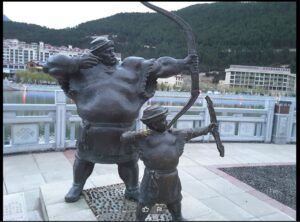
China now has considerable assets to protect in new era Nyingtri, a “municipality” almost the size of England. Those assets must not be disrupted by vagabond herders embodying Tibetan characteristics outside the sales pitch script. Hence the need for the “agricultural management law enforcement officers” 农业管理执法人员, nongyè guǎnlǐ zhífǎ rényuán, ready for battle.
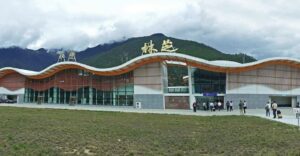
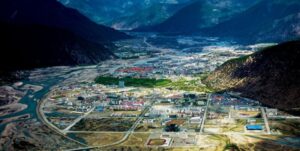
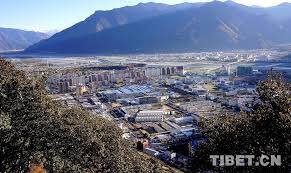
Post-pandemic, Nyingtri is back in business, staging its 20th annual peach blossom and culture festival in March 2023. Many of the illustrations in this blog are from the event. Before the pandemic lockdowns, business was booming. According to the Nyingtri Municipality in 2019: “The city received a total of 8.64 million domestic and foreign tourists, an increase of 21.1%, to achieve tourism revenue of 7.2 billion yuan, an increase of 21.6%, respectively, to complete the annual plan of 100.4% and 105.8%. The proportion of traditional tourists group is steadily declining, self-driving, self-help tourism mode and rural tourism products are developing rapidly, tourism consumption hotspots from urban centres continue to develop and extend around the town. 2019 January-October the city received a total of 3.219 million self-driving tourists, an increase of 31.28%, to achieve tourism revenue of 2.466 billion yuan, an increase of 48.7%. The peach blossom festival: During the Peach Blossom Festival (March 29-March 31), the city received 193,100 visitors, an increase of 14.12% year-on-year, and achieved a tourism income of 48,438,900 yuan, an increase of 47.91% year-on-year.”
Fortunes are being made in Nyingtri, by entrepreneurs catering to the new bio-cultural experience tourism market, happy to pay well for Tibetans to sell Tibetanised merch to Han tourists.
These are assets to be protected. The wool and carpet making industry in Nyingtri failed, the pork and apple farming state farms are on life support, but Nyingtri Peach Blossom Festival tourism is booming. In a party-state where all assets require maximum securitisation to protect them from threat, the ag police are weaponizing, in readiness. The pure land is being militarised.
Militarising the entire countryside of China now seems to be the purpose of the new enforcers of civilised conformity, and there is now widespread dismay across China that the obnoxious chengguan of city streets are being mirrored by nongguan policing the countryside.
There is a case for a specifically rural police, since farmers are often ripped off by sellers of fake seeds, fake fertiliser. Farmers do need protection FROM scams. What they don’t need is a new branch of uniformed, overzealous thugs enforcing arbitrary “civilised” behaviours.
The widespread dismay at the new “agricultural management law enforcement officers” means Tibetans are not alone in objecting. Those objections, and the language deployed to express objection, are vividly captured:
The new officers have been nicknamed nóngguǎn 农管, translated as “agricultural-management officers”. It’s a play on the phrase “urban-management officers”, or chéngguǎn 城管, who are among China’s most despised law enforcers.
China’s propaganda machine has sought to correct the narrative caused by the unhelpful nickname. But whether or not that is believed will depend on the actions of the new law enforcement officers:
The rural comprehensive law enforcement team has only just been established. So it must not be misrepresented and misinterpreted at the grassroots level. We must also be wary of people who abuse their powers and regard agricultural management as an opportunity for grassroots power violations and abuses, as well as a banner under which farmers can be tormented.
农村综合执法队伍刚成立不久,要防止其在基层被念歪了经、盖歪了楼,也要警惕有人“拿着鸡毛当令箭”,把“农管”当成基层越权、滥权、折腾农民的“虎皮大旗”
The suspicion also arises from a uniquely vague Chinese character hidden at the end of the job spec of the agricultural management officers:
The subtlety of the Chinese language encapsulated in the single character, “deng”, is what is so frightening. This is a backdoor for the infinite expansion of power, and gives the inherent attribute of declaring the right of interpretation. It means they can be the athletes and the referee in a match.
以汉字的精妙而言,最怕的就是一个“等”字,这是为扩权留下的无限大的后门,以及宣布解释权的自有属性,运动员与裁判合体。[1]
The character děng 等, which roughly translates as “etc” or “and so on” in Chinese can only be translated in context: It can mean anything, everything, or nothing. Cynical rural residents tend to think the worst, and assume it translates as “and anything else they want to meddle in”.
The Economist ran an article on this story too, in which one villager’s comments sum up the feeling in the countryside according to the reporter: “All crows under heaven are black”.
- In Chinese: 天下乌鸦一般黑 tiān xià wū yā yì bān hēi
In other words, the rural and urban police officers are all as bad as each other.
There are also lots of metaphors about China’s imperial past in the discussions. It’s a reminder that central power extending into the countryside is nothing new. It’s been around for millennia, and it has rarely been effective or welcome. Imperial envoys, pomp and fanfare often had limited reach in China’s remote countryside under dynastic rule.
Will the nongguan be different, go further, or perhaps even go too far?
- 农管 nóng guǎn
agricultural law enforcement administrators
全中国的人们正在目睹农管公开扩权的初始阶段 – People all over China are witnessing the initial stages of the public expansion of agricultural management. [1]
- 钦差 qīn chāi
imperial envoy
农村治理还是要更多依靠原有的组织体系,“农管”不能成为一批“钦差” – Rural governance still has to rely more on its own organizational system. Agricultural management officers cannot become a group of “imperial envoys”. [5]
- 拿着鸡毛当令箭 ná zhe jī máo dāng lìng jiàn
taking a chicken feather as an order; abuse powers
我们也要警惕有人“拿着鸡毛当令箭”,把“农管”当成基层越权、滥权、折腾农民的“虎皮大旗” – We must also be wary of people who “take a chicken feather as a warrant” and regard agricultural management as an opportunity for grassroots power violations and abuses, as well as a banner under which farmers can be tormented. [4]
- 拉大旗 ,作虎皮 lā dà qí, zuò hǔ pí
hoist a banner such as the tiger’s skin to intimidate others; abuse one’s powers
把“农管”当成基层越权、滥权、折腾农民的“虎皮大旗” – Treating “agricultural management” as a “tiger skin banner” for the grassroots to overreach, abuse power, and torment farmers. [4]
- 前事不忘,后事之师 qián shì bú wàng, hòu shì zhī shī
past experience is a teacher for the future
前事不忘后事之师,农管从兄弟部门城管那不仅借鉴经验,恐怕也要接受后者直到现在尚未“转正”的社会评价 – The past is the teacher of the future. Agricultural management officers may not only learn from the experience of the chengguan, their reputation is also closely linked – chengguan has never been regarded as “official” and is always looked down on.
- 坑农 kēng nóng
hurting farmers
这支队伍早已有之,在打击假种子、假化肥等“坑农”“害农”事 – This team has been around for a long time, and it is tackling issues like fake seeds, fake fertilizers that hurt farmers.
- Related: 害农 hài nóng – hurt farmers
- 后门 hòu mén
backdoor
以汉字的精妙而言,最怕的就是一个“等”字,这是为扩权留下的无限大的后门 – With Chinese characters, the word “deng” is the most feared, which offers an infinite number of back doors for power expansion. [1]
- 铁腕 tiě wàn
iron fist
一种整顿农村秩序的权力思维正以激进的铁腕试水 – A power mindset to improve rural order is testing the waters with a radical iron fist. [1]
- 冷眼 lěng yǎn
cold eyes
“农管”在农村开展工作时就可能被排斥,遭遇冷眼 – “Agricultural management” may be rejected and met with cold eyes when they carry out work in rural areas. [2]
- 瞎管 xiā guǎn
blind management; bad management
农管要做到准确执法,而非为了创造业绩,刷存在感,找各种事情瞎管 – Agricultural management must implement effective law enforcement. They should not actively look for things to “manage” in order to meet their performance target or to demonstrate their presence. [5]
- Related: 乱管 luàn guǎn – bad management
Three-character phrases
- 垫脚石 diàn jiǎo shí
stepping stone
想到的却是这八个方面的每一个都可以成为扩权的垫脚石 – What comes to mind is that each of these eight aspects can become a stepping stone to power expansion. [1]
- 土政策 tǔ zhèng cè
backward policy
这种一刀切的土政策哪怕与“农管”无关,但切实影响到农民的日常生活和生计 – Even if this one-size-fits-all bad policy has nothing to do with “agricultural management”, it actually affects the daily life and livelihood of farmers. [4]
- Related: 一刀切 yì dāo qiē – one size fits all policy
Idioms
- 惊惶不安 jīng huáng bù ān
panic
农业农村部法规司试图安抚惊惶不安的民意 – The Ministry of Agriculture and Rural Regulations is trying to reassure the panicked public. [1]
- Related: 忧心忡忡 yōu xīn chōng chōng – worried (惊惶不安 – means worried to the point of being paranoid)
- 杞人忧天 qǐ rén yōu tiān
like the man of Qi who feared that the sky might fall; alarmist
所有这些不信任与忧虑为何不是杞人忧天 – Why is this mistrust and concern not misplaced? [1]
- Note: The idiom story is about a man in the State of Qi who was haunted by the fear that the sky might fall one day. It tells us there is no need to have imaginary or groundless fears.
- 朝令夕改 zhāo lìng xī gǎi
(an order or a policy) change from day to day
对当下农村工作当中一些形式主义、教条主义、官僚主义、朝令夕改等问题的集体吐槽 – There are many complaints about some formalism, dogmatism, bureaucracy, and frequent policy changes in the management of rural areas. [4]
- 木已成舟 mù yǐ chéng zhōu
the wood is already made into a boat; what’s done is done
既然木已成舟,现在更重要的还是在制度层面如何监管好这支队伍 – Now that the deal is done, what is more important now is how to supervise this team at the institutional level. [5]
- 步入后尘 bù rù hòu chén
follow in the footsteps
不少人担心“农管”会不会也步后尘,成为盘踞在农民头上的官僚主义乌云 – Many people worry whether the agricultural management officers will follow in its footsteps and become a dark cloud of bureaucracy hanging over rural residents. [5]
- Note: A well known idiom from a Dù Fǔ 杜甫 poem, Six Play Quatrains 戏为六绝句 (xì wéi liù jué jù).
- 九龙治水 jiǔ lóng zhì shuǐ
nine dragons managing the water; too many cooks spoil the broth
也是为了纠正多年来地方尤其是县级农业部门内部多头分散执法,“九龙治水”的问题 – It is to correct the problem of there being too many departments involved for many years in local and especially county-level agricultural departments. [4]
- 鸣锣开道 míng luó kāi dào
sound the gong and clear the way
要坚决防止这支队伍为农村地区的形式主义鸣锣开道 – We must resolutely prevent this team from clearing the way for formalism in rural areas. [5]
- Note: A reference to China’s imperial past; When a Minister would walk down a street in ancient China, gongs and bells would be sounded as a sign of authority, and to encourage people to move out of the way.
Phrases
- 皇权不下县 huáng quán bú xià xiàn
imperial power does not reach the countryside
“皇权不下县”是自由主义的羸弱论调,早已过时 – “Imperial power does not go down to the county” is a weak argument of liberalism, which is now long outdated. [1]
- 歪嘴和尚念歪经 wāi zuǐ hé shang niàn wāi jīng
crooked mouth monk makes scriptures sound crooked; misinterpreting policies
要防止其在基层被念歪了经、盖歪了楼 – It is necessary to prevent them from misinterpreting policies at the grassroots level. [4]
- 迅雷不及掩耳之势 xùn léi bù jí yǎn ěr zhī shì
lightning fast
农管的扩权进程犹如迅雷不及掩耳之势,说明部门做了充分的准备 – The power expansion of agricultural management has been rapid. This shows that the department has made sufficient preparations. [1]
- 闲不住的手 xián bú zhù de shǒu
the meddling hand of government
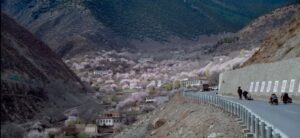
[1] Luigi Tomba, The Government Next Door: Neighbourhood politics in urban China, Cornell, 2014, 144
[2] Stevan Harrell, Foreword in R Harwood, China’s New Socialist Countryside: Modernity arrives in the Nu River valley, U Washington Press, 2014, ix-x
[3] Ruth Gamble (2022): Surviving Pemakö’s pluriverse: Kunga Tsomo, the goddess, and the LAC, Critical Asian Studies, 10
[4][4] TAR Statistical Yearbook 2021, table 17-7, Output of milk, sheep and goat wool products.
[5] Barbara Hazelton, Padma bkod through the Lens of Two Pilgrimage Guidebooks: Walking the Body of Rdo rje phag mo, 144-6 in Frances Garrett ed, Hidden Lands in Himalayan Myth and History: Transformations of sbas yul through Time, Brill 2021
[6] Lin Zhang, The Labor of Reinvention: Entrepreneurship in the New Chinese Digital Economy, Columbia University Press 2023
[7] David Ownby, in Xiang Biao and Wu Qi , Self as Method : Thinking Through China and the World, Palgrave open access, 2023, 16
[8] Jessica Teets, Civil Society under Authoritarianism: The China Model, Cambridge U Press, 2014, 121
[9] Pal Nyiri, Scenic Spots : Chinese Tourism, the State, and Cultural Authority, University of Washington Press, 2011.
[10] Salman Yousaf, Xiucheng Fan, Copysites / duplitectures as tourist attractions: An exploratory study on experiences of Chinese tourists at replicas of foreign architectural landmarks in China, Tourism Management 81 (2020) 104179

